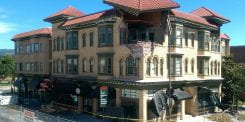U.S. scientists celebrate Nobel Prize for Higgs field discovery
Irvine, Calif., Oct. 8, 2013 — The Royal Swedish Academy of Sciences today awarded the Nobel Prize in physics to theorists Peter Higgs and Francois Englert to recognize their work in developing the theory of what is now known as the Higgs field, which gives elementary particles mass. U.S. scientists, including those at UC Irvine, played a significant role in the research and in discovering the particle that proves the existence of the Higgs field, the Higgs boson.
In the 1960s, Higgs Englert, Robert Brout, Tom Kibble and Americans Carl Hagen and Gerald Guralnik, published studies introducing key concepts in the theory of the Higgs field. In 2012, scientists on the international ATLAS and CMS experiments, performed at the Large Hadron Collider at the CERN laboratory in Europe, confirmed this theory when they announced the discovery of the Higgs boson.
Nearly 2,000 physicists from U.S. institutions – including 89 U.S. universities and seven U.S. Department of Energy laboratories – participate in the ATLAS and CMS experiments, making up about 23 percent of the ATLAS collaboration and 33 percent of CMS at the time of the Higgs discovery. Brookhaven National Laboratory serves as the U.S. hub for the ATLAS experiment, and Fermi National Accelerator Laboratory serves as the U.S. hub for the CMS experiment. U.S. scientists provided a significant portion of the intellectual leadership on Higgs analysis teams for both experiments.
“It is an honor that the Nobel Committee recognizes these theorists for their role in predicting what is one of the biggest discoveries in particle physics in the last few decades,” said Fermilab Director Nigel Lockyer. “I congratulate the whole particle physics community for this achievement.”
The majority of U.S. scientists participating in LHC experiments work primarily from their home institutions, remotely accessing and analyzing data through high-capacity networks and grid computing. Eight UC Irvine faculty members and many postdoctoral researchers, students and staff members are involved with the LHC. They develop electronics, computer systems and software integral to collecting and recording data.
“This is a fantastic achievement, a demonstration of both the predictive power of theoretical physics applied by brilliant minds to conceive the Higgs field and the ingenuity of scientists to address unprecedented technical challenges to its observation. It’s exciting that we at UCI played a role in this discovery,” said Andrew Lankford, UC Irvine professor of physics & astronomy who, until recently, was the deputy director of the ATLAS experiment.. “Nonetheless, observation is just the start. We’ll now study the properties of the Higgs boson and search for possible partners and other new particles as we solve other puzzles of the subatomic world and ultimately the cosmos.”
More information on UC Irvine’s role in the project can be found on our “New Physics Frontier” page.
The U.S. provides 23 percent of the computing power for ATLAS and 40 percent for CMS. U.S. scientists also supplied or played a leading role in several main components of the two detectors and the LHC accelerator, amounting to a value of $164 million for the ATLAS detector, $167 million for the CMS detector and $200 million for the LHC. Support for the U.S. effort comes from the U.S. Department of Energy Office of Science and the National Science Foundation.
“It’s wonderful to see a 50-year-old theory confirmed after decades of hard work and remarkable ingenuity,” said Brookhaven National Laboratory Director Doon Gibbs. “The U.S. has played a key role, contributing scientific and technical expertise along with essential computing and data analysis capabilities – all of which were necessary to bring the Higgs out of hiding. It’s a privilege to share in the success of an experiment that has changed the face of science.”
The discovery of the Higgs boson at CERN was the culmination of decades of effort by physicists and engineers around the world, at the LHC but also at other accelerators such as the Tevatron accelerator, located at Fermilab in Batavia, Ill., and the Large Electron Positron accelerator, which once inhabited the tunnel where the LHC resides outside of Geneva, Switzerland. Work by scientists at the Tevatron and LEP developed search techniques and eliminated a significant fraction of the space in which the Higgs boson could hide.
About the University of California, Irvine: Located in coastal Orange County, near a thriving high-tech hub in one of the nation’s safest cities, UC Irvine was founded in 1965. One of only 62 members of the Association of American Universities, it’s ranked first among U.S. universities under 50 years old by the London-based Times Higher Education. The campus has produced three Nobel laureates and is known for its academic achievement, premier research, innovation and anteater mascot. Led by Chancellor Michael Drake since 2005, UC Irvine has more than 28,000 students and offers 192 degree programs. It’s Orange County’s second-largest employer, contributing $4.3 billion annually to the local economy.
Media access: UC Irvine maintains an online directory of faculty available as experts to the media at http://communications.uci.edu/for-journalists/experts/. Radio programs/stations may, for a fee, use an on-campus ISDN line to interview UC Irvine faculty and experts, subject to availability and university approval. For more UC Irvine news, visit wp.communications.uci.edu. Additional resources for journalists may be found at communications.uci.edu/for-journalists.

